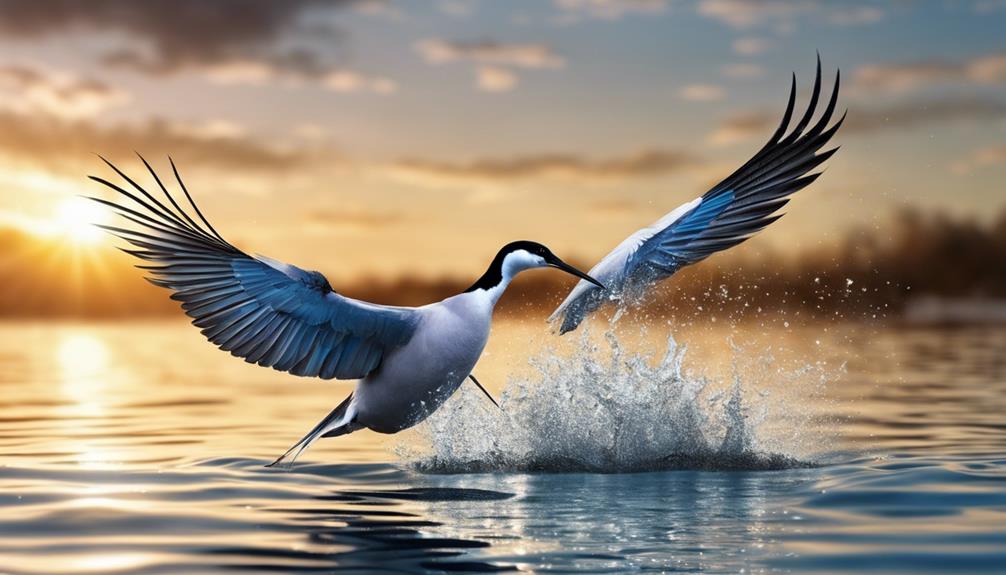Curious to learn about the 13 amazing water diving birds that possess remarkable underwater skills? From the streamlined cormorants to the agile penguins, these avian creatures navigate the depths with finesse.
But what sets them apart and makes them exceptional divers? Discover the secrets behind their aquatic prowess and unravel the mysteries of their underwater world.
Explore how these birds have adapted to thrive in diverse environments and uncover the intriguing tales that define them. Prepare to be fascinated by the enthralling tales of these feathered divers as you journey through their watery domain.
Cormorants
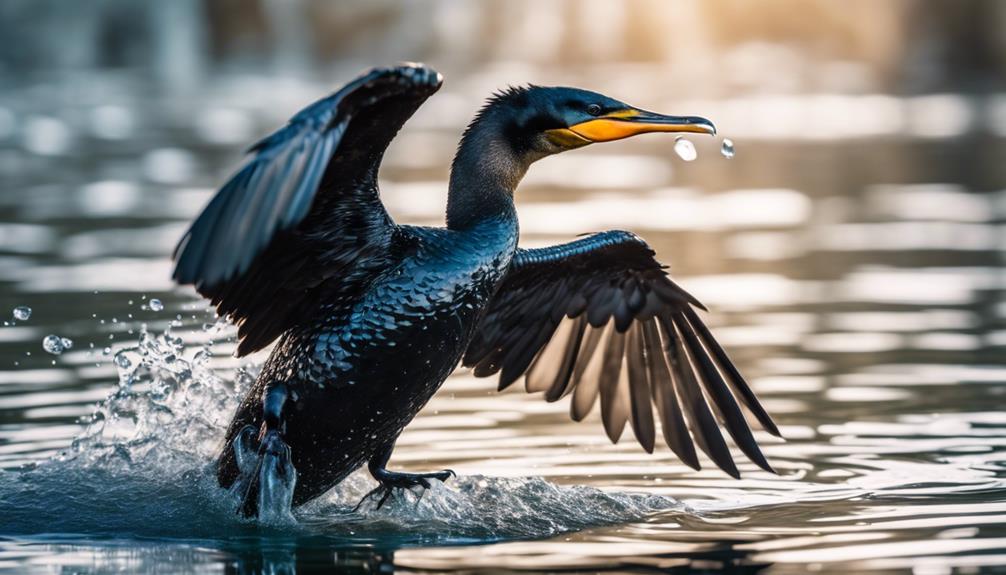
Cormorants, known for their exceptional diving and swimming abilities, demonstrate remarkable hindlimb features for efficient underwater navigation. These birds possess elongated bodies and powerful webbed feet that propel them swiftly through the water. Their streamlined shape reduces water resistance, enabling them to dive to impressive depths in search of prey.
When hunting underwater, cormorants use their agile hindlimbs to maneuver swiftly and accurately. Their feet act like oars, helping them steer and maintain balance as they chase fish beneath the surface. These hindlimb adaptations are essential for cormorants to navigate effectively in their aquatic environment.
Moreover, cormorants have strong leg muscles that provide the necessary power for swift propulsion. This muscular strength allows them to dive quickly and with precision, making them formidable hunters underwater. Essentially, the hindlimb features of cormorants play a crucial role in their ability to thrive in aquatic habitats, showcasing their remarkable adaptation for underwater navigation.
Loons
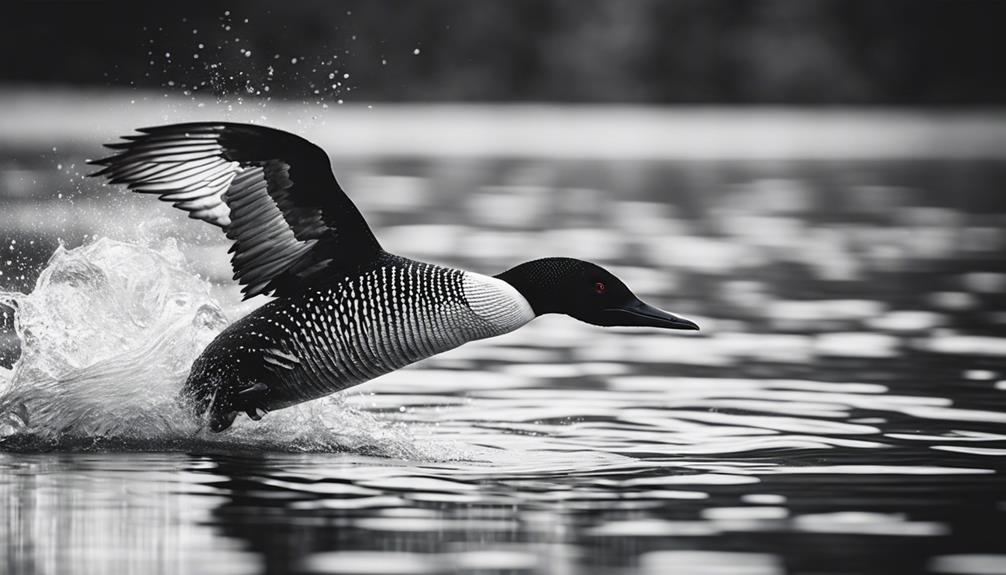
Known for their haunting calls and sleek black-and-white plumage, loons are remarkable diving birds that captivate observers with their grace and underwater prowess. These birds, found in North America and Europe, are well-known for their exceptional diving abilities. Loons have solid bones that make them less buoyant, enabling them to dive to impressive depths of up to 200 feet in search of fish, their primary food source. Their streamlined bodies and webbed feet contribute to their agility underwater, where they use their powerful legs to propel themselves in pursuit of prey. Loons are also equipped with sharp, pointed bills that aid in catching and consuming their aquatic meals.
Additionally, loons are famous for their eerie calls that echo across lakes and ponds, adding to their mystique. These vocalizations serve various purposes, including territorial marking and communication. With their striking appearance and remarkable diving skills, loons are truly fascinating birds to observe in their natural aquatic habitats.
Pochards
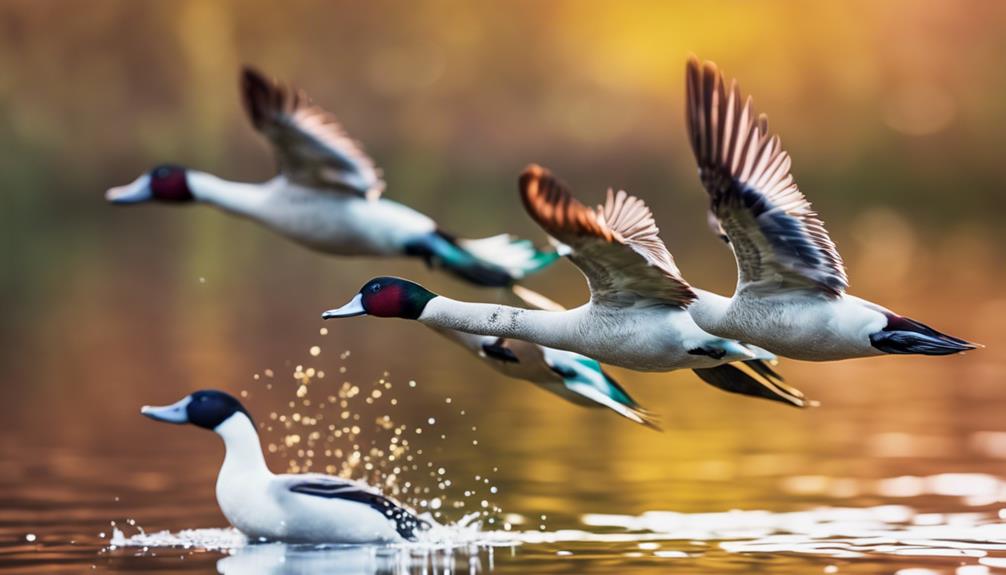
With their distinctive red head and striking black and white body, pochards are enchanting diving birds renowned for their diving prowess and elegant swimming skills. These medium-sized birds belong to the diving duck family and are known for their ability to consider underwater in search of food. Pochards have specialized adaptations such as webbed feet and waterproof plumage that enable them to navigate through water effortlessly.
These birds primarily feed on aquatic plants, insects, and small fish, considering to considerable depths to forage for their meals. Pochards are often found in freshwater lakes, reservoirs, and marshes where they can consider and swim with ease. Their unique red head, contrasting with their black and white body, makes them stand out among other waterfowl species.
If you ever have the chance to observe pochards in their natural habitat, you'll be captivated by their graceful considers and agile swimming movements. These diving birds truly showcase the beauty and adaptability of nature in water environments.
Grebes
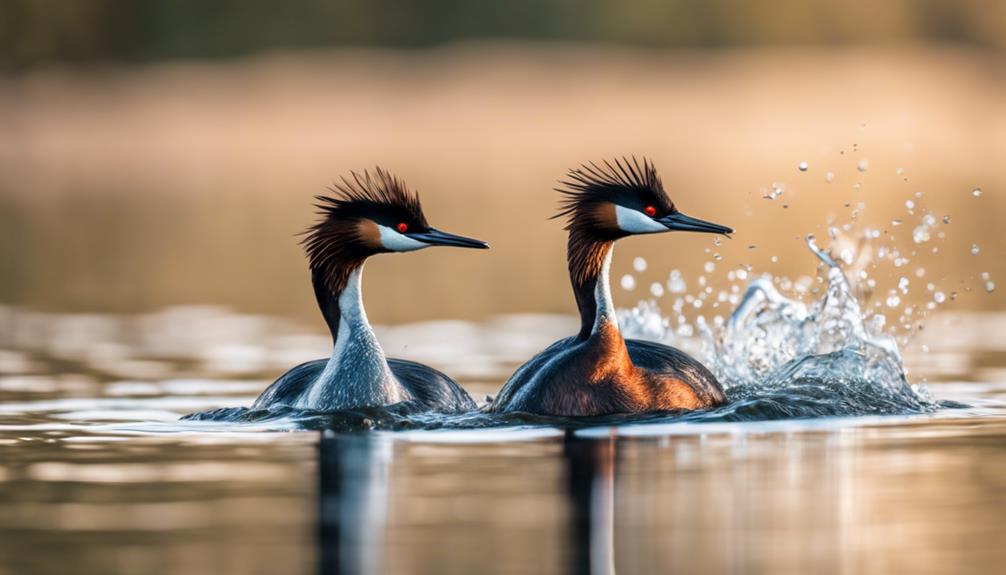
When observing water diving birds, one fascinating species to study is the grebe, known for its unique diving abilities and distinctive plumage. Grebes belong to the family Podicipedidae and are expert divers, using their lobed toes to propel themselves underwater. These birds are adept at catching fish and aquatic invertebrates during their dives, showcasing remarkable agility and precision in their hunting techniques.
Grebes are characterized by their striking black-and-white patterns and elegant neck movements. Their ability to dive underwater for extended periods enables them to thrive in freshwater lakes and ponds, where they can be seen gracefully navigating through the water in search of food. Grebes are also known for their elaborate courtship displays, involving intricate dances and rituals that demonstrate their bond with their mates.
Next time you're near a body of water, keep an eye out for these captivating grebes as they dive and swim with grace and skill, showcasing the beauty and adaptability of water diving birds.
Penguins
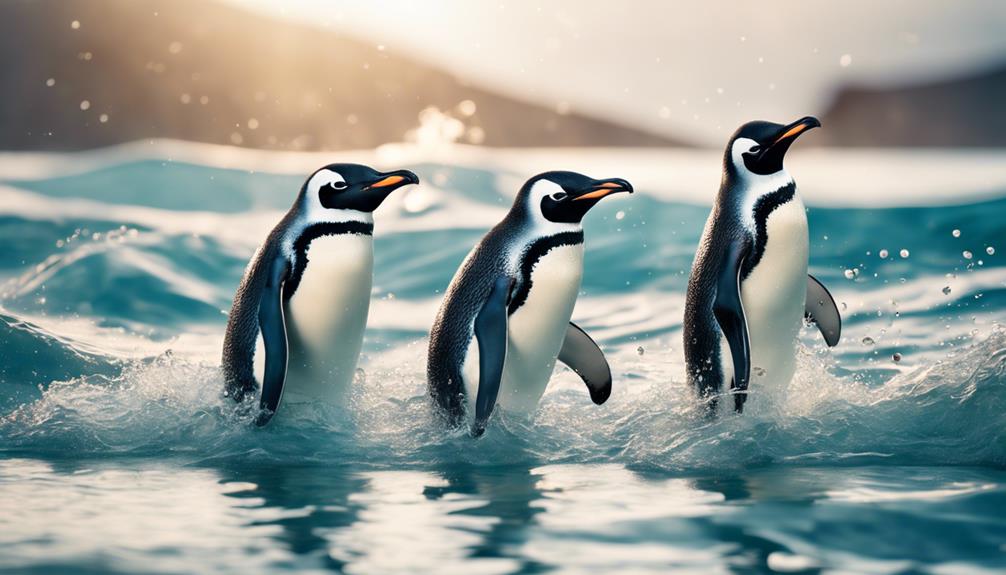
Observing penguins in their natural habitat reveals their remarkable swimming and plunging prowess. These charismatic birds are exceptional swimmers, using their flippers to glide gracefully through the water. Penguins can submerge to impressive depths, with some species reaching over 500 feet underwater in search of food.
Their streamlined bodies and waterproof feathers enable them to navigate the ocean with ease, propelling themselves through the water with precision. Penguins display incredible agility and speed while hunting for fish, squid, and other marine creatures beneath the surface. Their unique adaptations, such as dense bones for buoyancy control and specialized respiratory systems for extended plunges, make them well-suited for life in the water.
As social animals, penguins often submerge in groups, coordinating their movements to maximize hunting success. Witnessing these elegant birds in action showcases the remarkable capabilities that have allowed them to thrive in diverse aquatic environments.
Diving Petrels
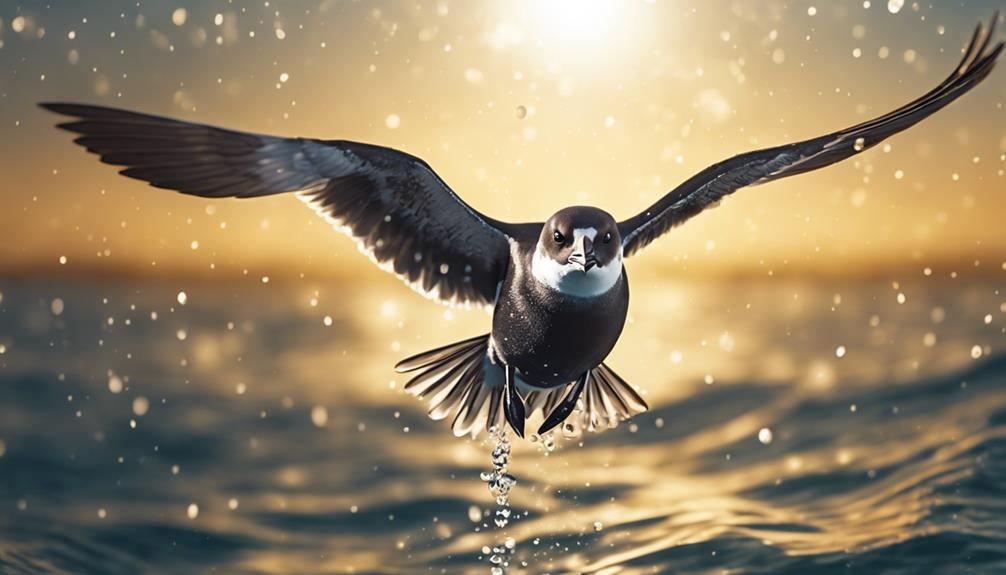
After exploring the remarkable swimming abilities of penguins, let's now focus on the fascinating world of Diving Petrels. Diving Petrels are exceptional seabirds known for their remarkable diving skills. These birds, belonging to the Procellariidae family, are adept at plunging into the depths of the ocean in search of food. With their streamlined bodies and wings adapted for underwater propulsion, Diving Petrels can reach impressive depths while hunting for fish, squid, and crustaceans.
One of the most remarkable characteristics of Diving Petrels is their ability to dive deep underwater, sometimes reaching depths of up to 30 meters. These birds use their wings to 'fly' underwater, propelling themselves with precision and agility to catch their prey. Diving Petrels often feed near the surface but are also capable of diving to significant depths to secure their meals. Their remarkable underwater prowess and streamlined bodies make them well-suited for life in the ocean, where they spend a significant portion of their time hunting and foraging.
Shearwaters
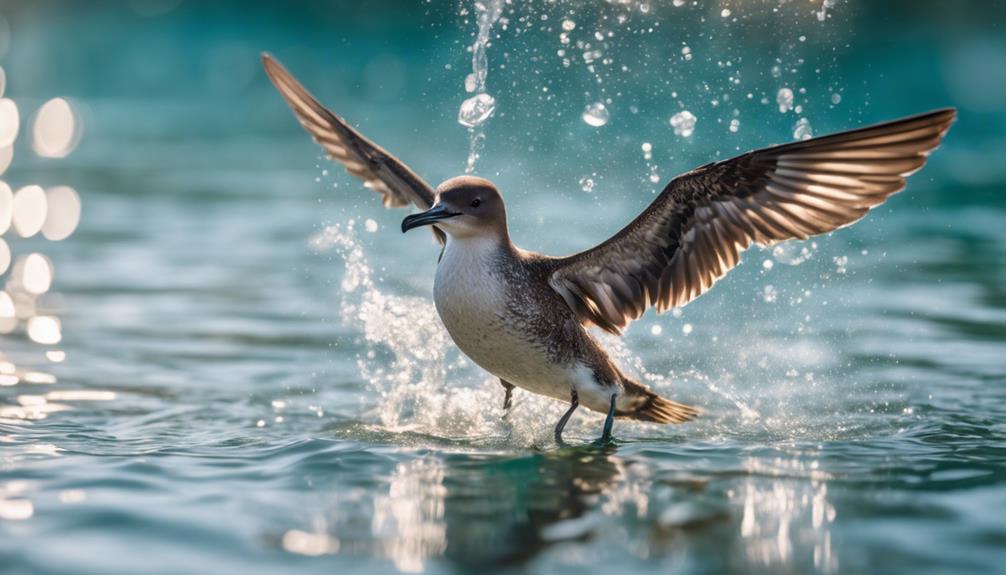
Shearwaters, known for their graceful flight and remarkable diving abilities, are seabirds that captivate with their sleek appearance and efficient hunting techniques. These birds belong to the Procellariidae family and are excellent long-distance travelers, covering vast ocean expanses with assess. Shearwaters possess hydrodynamic bodies that allow them to dip deeply into the water in pursuit of prey, primarily feeding on fish and squid. Their streamlined bodies and long, narrow wings enable them to glide effortlessly above the ocean surface and plunge into the depths with precision.
One fascinating aspect of shearwaters is their ability to dip for considerable depths, reaching up to 60 meters below the surface in pursuit of food. These birds use their keen eyesight to spot prey underwater, then swiftly dip down to catch it. Shearwaters' hunting techniques are a marvel to witness, showcasing their agility and effectiveness in capturing food beneath the waves. Overall, shearwaters exemplify the beauty and efficiency of water diving birds with their impressive aerial acrobatics and skilled underwater hunting prowess.
Puffins
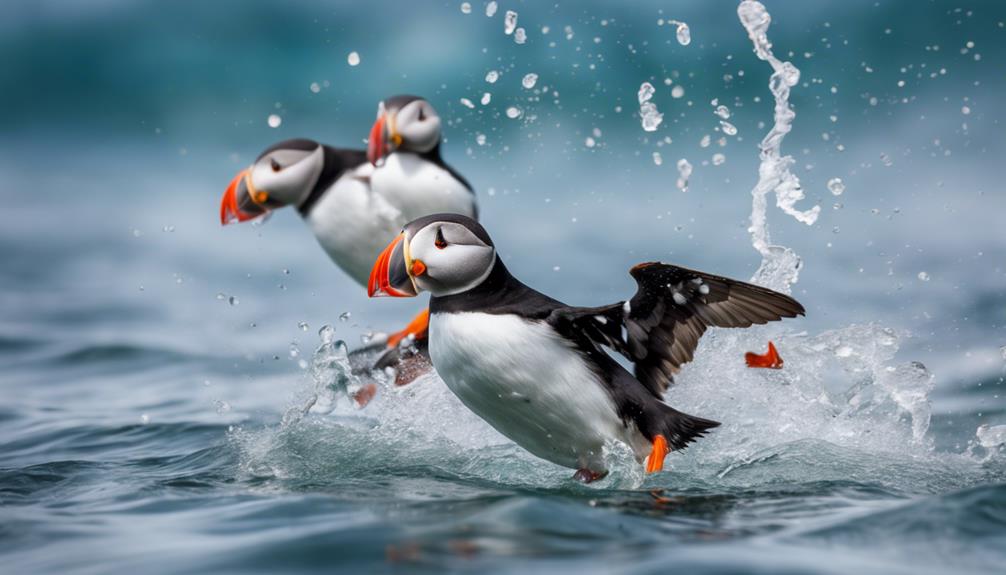
Puffins, renowned for their colorful beaks and charming appearances, exhibit remarkable diving skills comparable to shearwaters, showcasing their adeptness in capturing prey underwater.
These compact seabirds possess streamlined bodies ideally suited for swift underwater navigation. With their short wings, they propel themselves underwater using their webbed feet, reaching depths of up to 60 meters in search of small fish like sand eels and herring.
Puffins can stay submerged for up to a minute, utilizing their sharp, triangular bills to grasp and secure their slippery prey. Despite their somewhat clumsy appearance on land, puffins transform into agile hunters underwater, darting through the ocean with precision and speed.
Their unique adaptations, such as specialized beaks and waterproof feathers, enable them to thrive in their marine environments. Observing puffins in action is a true marvel, as they effortlessly navigate the depths with grace and efficiency, embodying the essence of skilled water diving birds.
Gannets
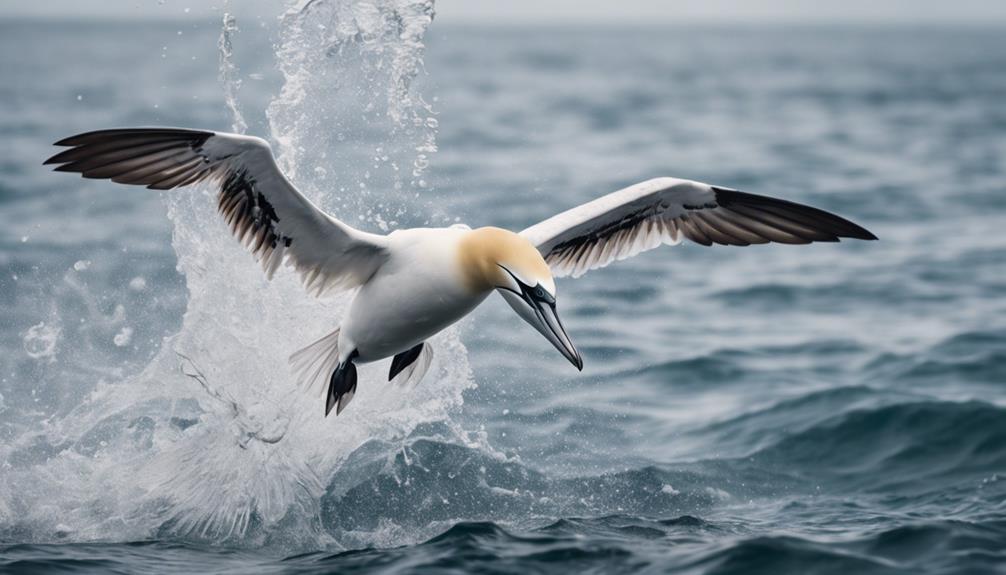
Gannets demonstrate exceptional plunging prowess, showcasing their adeptness in capturing prey with precision underwater. These magnificent seabirds are known for their remarkable plunge-diving abilities, where they fold their wings back and plummet into the water from great heights to catch fish.
Gannets have streamlined bodies and long wings that enable them to plummet into the sea like arrows, reaching impressive depths of up to 22 meters. Their keen eyesight allows them to spot fish from high above the water's surface before executing their rapid and precise plunges.
Once submerged, gannets use their webbed feet to steer through the water with agility, swiftly maneuvering to capture their prey. Their sharp beaks are designed to grasp and secure fish effectively, making them efficient hunters in their marine environment.
Watching gannets in action is a proof of their incredible plunging skills and adaptability to thrive in the challenging underwater world.
Boobies
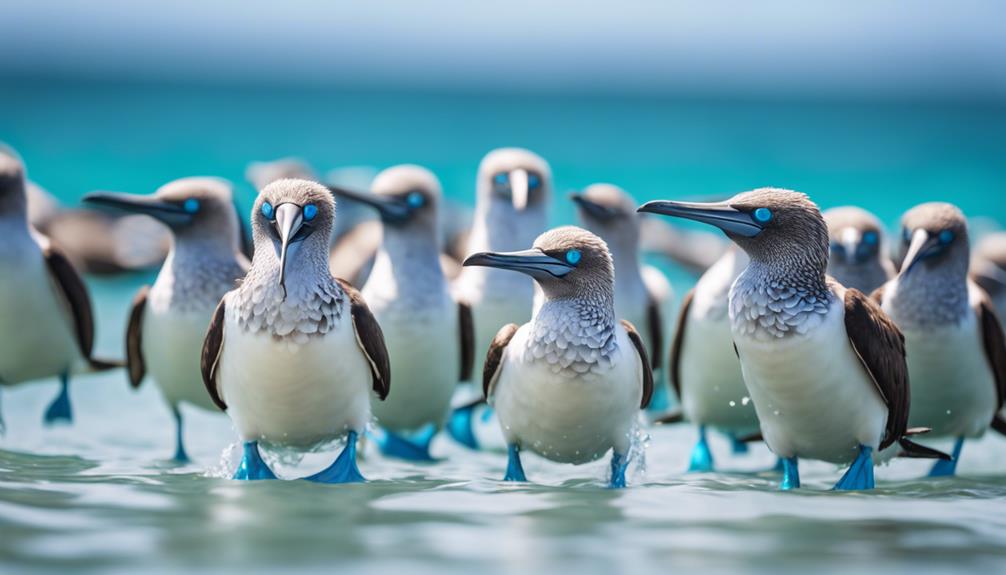
Boobies, another fascinating species of water diving birds, exhibit remarkable aerial prowess and precision in hunting for prey underwater. These seabirds, known for their distinctive blue feet and long pointed bills, are expert plunge divers. Boobies soar high above the water, using their keen eyesight to spot schools of fish. With swift and agile movements, they fold their wings back and dive headfirst into the ocean at incredible speeds, reaching impressive depths in pursuit of their prey.
Boobies possess specialized adaptations for diving, including streamlined bodies and strong wings for rapid descent. Their exceptional hunting strategies involve using gravity to propel themselves underwater, where they skillfully maneuver to catch fish with precision. These birds can adjust their diving angles and speeds to maximize their hunting efficiency, making them formidable predators in the marine environment.
Next time you catch a glimpse of a booby gracefully diving into the sea, take a moment to appreciate the incredible aerial acrobatics and hunting skills of these remarkable water diving birds.
Terns
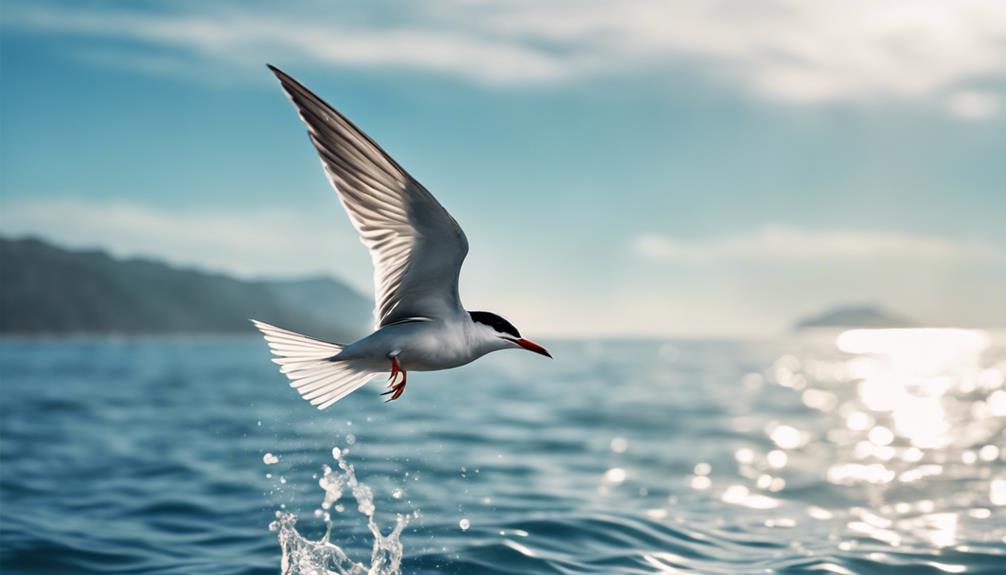
Known for their graceful aerial maneuvers and swift hunting abilities, terns are fascinating water plunging birds found in various coastal regions around the world. These sleek birds are known for their long, pointed wings, forked tails, and sharp bills, which they use to submerge into the water with remarkable precision.
Terns primarily feed on small fish, submerging into the water from heights as they spot their prey. With their excellent eyesight, terns can pinpoint fish beneath the water's surface before submerging down to catch them with swift and agile movements. Their streamlined bodies and aerodynamic shapes allow them to navigate the air and water effortlessly.
These agile hunters are efficient at catching fish, often seen performing acrobatic plunges and twists to secure their meals. Terns' remarkable submerging skills and adaptability make them an essential part of coastal ecosystems, contributing to the balance of marine life through their hunting prowess and graceful presence in the skies and waters.
Kingfisher
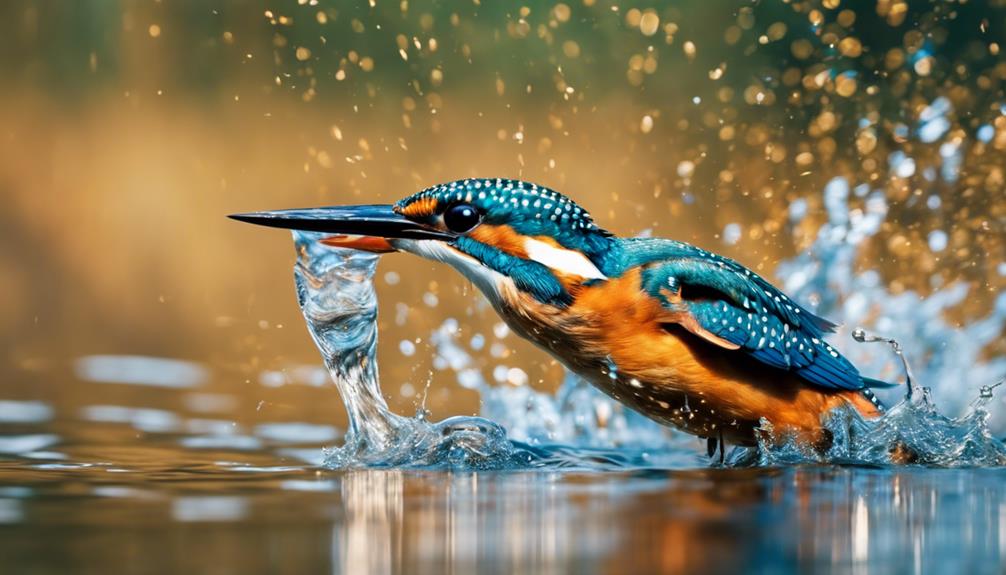
With their vibrant plumage and swift hunting techniques, the Kingfishers stand out as enthralling water birds in various ecosystems worldwide. These stunning birds are known for their remarkable fishing abilities, diving into the water with incredible precision to catch fish. Kingfishers possess a distinctive long, sharp bill ideal for snatching their aquatic prey swiftly.
Their exceptional eyesight enables them to spot fish even beneath the water's surface, allowing for efficient hunting. Kingfishers are often observed perched near water bodies, patiently waiting for the opportune moment to plunge into the water. Once they spot a fish, they dive headfirst with remarkable speed, emerging with their catch clasped tightly in their beak.
Their streamlined bodies and powerful wings aid in swift underwater navigation, making them highly successful hunters. Kingfishers' distinctive hunting tactics and colorful appearance make them a fascinating addition to the diverse array of water diving birds.
Ospreys
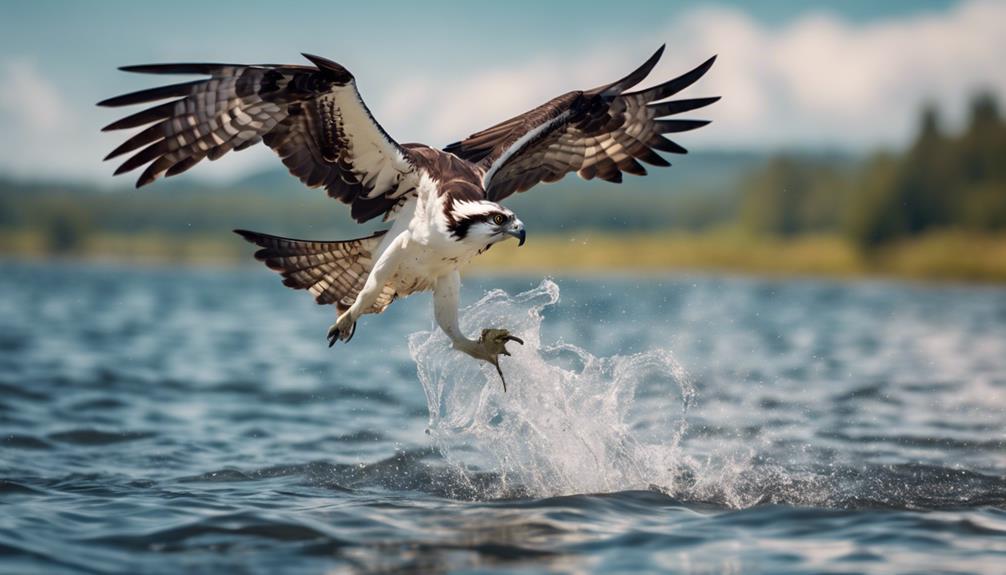
Ospreys demonstrate unique diving behaviors, showcasing their ability to wholly submerge while hunting for fish. These magnificent birds, also known as sea hawks or fish eagles, possess distinct physical adaptations that make them exceptional divers.
With reversible outer toes, barbed pads on their feet, and oily feathers that repel water, ospreys are perfectly equipped for their diving expeditions. Their keen eyesight aids in spotting fish below the water's surface, after which they dramatically plunge feet-first to snatch their prey with sharp talons.
Ospreys can adjust the angle and depth of their dives, reaching impressive speeds of up to 80 km/h (50 mph) before skillfully grabbing their meal. Once they secure their catch, ospreys expertly lift themselves out of the water and shake off excess droplets before flying away.
Witnessing an osprey in action is a true spectacle of nature's precision and grace, illustrating the mastery these birds exhibit in the art of underwater hunting.

Erzsebet Frey (Eli Frey) is an ecologist and online entrepreneur with a Master of Science in Ecology from the University of Belgrade. Originally from Serbia, she has lived in Sri Lanka since 2017. Eli has worked internationally in countries like Oman, Brazil, Germany, and Sri Lanka. In 2018, she expanded into SEO and blogging, completing courses from UC Davis and Edinburgh. Eli has founded multiple websites focused on biology, ecology, environmental science, sustainable and simple living, and outdoor activities. She enjoys creating nature and simple living videos on YouTube and participates in speleology, diving, and hiking.
🌿 Explore the Wild Side!
Discover eBooks, guides, templates and stylish wildlife-themed T-shirts, notebooks, scrunchies, bandanas, and tote bags. Perfect for nature lovers and wildlife enthusiasts!
Visit My Shop →
